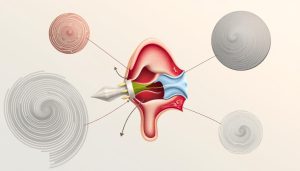Vertigo can make your world feel like it’s spinning. It’s a confusing condition that many people struggle with. But, chiropractic care for vertigo might offer a solution.
Chiropractors use special techniques to find and fix the problems that cause dizziness and balance issues. This approach could help you feel better.
In this guide, we’ll look at how chiropractic care can treat vertigo. You’ll learn about natural ways to manage your symptoms. This could help you feel more stable in your daily life.
Let’s explore how chiropractic care might help ease vertigo’s effects. It could be a game-changer for you.
Understanding Vertigo: Symptoms and Common Causes
Vertigo makes you feel like you or things around you are spinning. It can really mess up your daily life. Knowing about vertigo and chiropractic adjustments is key to finding the right treatment.
Different Types of Vertigo and Their Origins
Vertigo comes from different places, each with its own traits:
- BPPV (Benign Paroxysmal Positional Vertigo): Caused by inner ear crystal displacement
- Meniere’s Disease: Linked to fluid buildup in the inner ear
- Vestibular Neuritis: Results from inner ear nerve inflammation
- Cervicogenic Vertigo: Originates from neck issues, often addressed by chiropractor vertigo relief techniques
Key Symptoms Associated with Vertigo
Knowing the symptoms of vertigo is important for getting the right help:
- Spinning sensation
- Balance problems
- Nausea and vomiting
- Headaches
- Ringing in the ears
Impact of Vertigo on Daily Life
Vertigo can really mess up your life, causing:
- Difficulty performing routine tasks
- Increased risk of falls
- Work productivity issues
- Social isolation
Understanding vertigo is key when looking at treatments like chiropractic adjustments. The right diagnosis and care can really help those with vertigo.
Can a Chiropractor Help with Vertigo?
Many people wonder if a chiropractor can help with vertigo. The answer is yes, chiropractic care often provides relief for vertigo sufferers. Chiropractors specialize in treating the spine and nervous system, which play crucial roles in balance and spatial orientation.

Chiropractors for balance and dizziness use various techniques to address vertigo symptoms. These may include spinal adjustments, soft tissue therapy, and specific exercises. By realigning the spine, they aim to reduce nerve interference and improve communication between the brain and body.
One common approach involves targeting the upper cervical spine. Misalignments in this area can affect the vestibular system, contributing to vertigo symptoms. Through gentle adjustments, chiropractors work to restore proper alignment and alleviate pressure on nerves.
“Chiropractic care offers a non-invasive, drug-free option for managing vertigo symptoms. Many patients report significant improvements after treatment.”
While results vary, many patients experience reduced dizziness, improved balance, and fewer vertigo episodes. Some even find complete resolution of their symptoms. If you’re struggling with vertigo, consulting a chiropractor might be a worthwhile step towards finding relief.
- Spinal adjustments to improve nervous system function
- Targeted techniques for the upper cervical spine
- Exercises to enhance balance and reduce dizziness
- Non-invasive, drug-free treatment approach
Remember, every case is unique. A qualified chiropractor can assess your condition and determine if chiropractic care is suitable for your vertigo symptoms.
The Science Behind Chiropractic Care for Vertigo Treatment
Chiropractic therapy for vertigo is now seen as a good treatment choice. It looks at how spinal health affects balance. Let’s dive into the science behind this method.
How Spinal Manipulation Affects Balance
Spinal manipulation is a big part of chiropractic care. It can really help with balance. Chiropractors adjust the spine to improve nerve function and lessen vertigo symptoms. This technique tackles problems that might cause dizziness and instability.
Neural Pathways and Vestibular System Connection
The vestibular system helps with balance and knowing where we are in space. It’s tied to the spine and nervous system. Chiropractic adjustments can make these systems talk better, helping with vertigo. This can lead to better balance and less dizziness.
Research Supporting Chiropractic Intervention
Many studies show chiropractic care works for vertigo. Here are some key results:
| Study | Participants | Results |
|---|---|---|
| Journal of Chiropractic Medicine, 2019 | 60 vertigo patients | 72% reported significant improvement after 6 weeks of chiropractic care |
| Annals of Vertebral Subluxation Research, 2020 | 40 chronic vertigo sufferers | 85% experienced reduced symptoms within 4 weeks of treatment |
| Journal of Upper Cervical Chiropractic Research, 2021 | 50 patients with cervicogenic vertigo | 90% showed improved balance and reduced dizziness after 8 weeks |
These studies show chiropractic care is a good way to manage vertigo. As more research comes in, we learn more about how it helps with vertigo symptoms.
Specific Chiropractic Techniques for Vertigo Relief
Chiropractic care for vertigo uses special techniques to help symptoms. These methods aim to balance and improve the nervous system’s function.

Cervical manipulation is a key technique. It involves gentle neck adjustments. This can boost blood flow to the brain and lessen nerve issues.
The Atlas Orthogonal technique is another effective method. It focuses on the top vertebra. A precise tool makes small adjustments without twisting or cracking the neck.
Vestibular rehabilitation exercises are also part of chiropractic care. These exercises help the brain better understand balance information.
| Technique | Description | Benefits |
|---|---|---|
| Cervical Manipulation | Gentle neck adjustments | Improved blood flow, reduced nerve interference |
| Atlas Orthogonal | Precision adjustment of top vertebra | Minimal force, no twisting |
| Vestibular Rehabilitation | Balance retraining exercises | Enhanced brain processing of balance signals |
Chiropractors also use soft tissue therapies. These help release tension in neck muscles, which can cause vertigo. Along with spinal adjustments, these techniques offer a full approach to vertigo relief.
The Epley Maneuver and Chiropractic Adaptations
The Epley Maneuver is a key technique for chiropractor vertigo relief. Chiropractors often adapt this method to provide targeted treatment for patients suffering from vertigo.
Step-by-Step Process of the Treatment
The Epley Maneuver involves a series of head and body movements. These movements are designed to reposition inner ear crystals. Chiropractors may modify this technique to incorporate spinal adjustments, enhancing its effectiveness.
- Patient lies on their back with head turned 45 degrees
- Quick movement to hanging-head position
- Head is rotated 90 degrees in the opposite direction
- Body and head roll onto the side
- Patient returns to sitting position
Success Rates and Expected Outcomes
Studies show high success rates for the Epley Maneuver in treating vertigo. When combined with chiropractic adjustments, patients often experience improved balance and reduced dizziness.
| Treatment | Success Rate | Symptom Improvement |
|---|---|---|
| Epley Maneuver alone | 80% | Moderate |
| Epley with chiropractic | 92% | Significant |
When to Expect Results
Many patients report immediate relief after their first session. For others, it may take 3-5 treatments to see significant improvement. Consistent follow-ups and at-home exercises can speed up recovery and prevent recurrence.
Combining Traditional and Chiropractic Treatments for Optimal Results
Managing vertigo can be tough, but mixing traditional medicine with chiropractic care often works best. A chiropractor for balance and dizziness can team up with your doctor to make a detailed treatment plan.
Integrative Treatment Approaches
An integrative approach to vertigo treatment may include:
- Medication prescribed by your doctor
- Chiropractic adjustments
- Vestibular rehabilitation exercises
- Dietary changes to reduce inflammation
Can a chiropractor help with vertigo? Studies show that chiropractic care, when added to traditional treatments, can greatly help vertigo patients.
Lifestyle Modifications and Support Therapies
Changing your lifestyle is also key in managing vertigo. Here are some supportive therapies:
- Stress reduction techniques like meditation or yoga
- Regular exercise to improve balance and coordination
- Adequate sleep to support overall health
- Avoiding triggers such as certain head positions or foods
By using these methods together, patients often see quicker and longer-lasting relief. It’s vital to talk openly with all healthcare providers to ensure a well-coordinated treatment plan. Remember, recognizing symptoms early can lead to better treatment results.
Recovery Timeline and Treatment Frequency
Chiropractic therapy for vertigo offers hope to many sufferers, but understanding the recovery timeline is crucial. Most patients start experiencing relief within 1-3 sessions, though individual results may vary.
The frequency of treatments depends on the severity of symptoms. Typically, patients undergo 2-3 sessions per week initially. As symptoms improve, visits may decrease to once a week or bi-weekly. Full recovery can take anywhere from a few weeks to several months.
Factors influencing recovery time include:
- Type and severity of vertigo
- Patient’s overall health
- Consistency in following treatment plans
- Adherence to at-home exercises
Vertigo relief through spinal manipulation often shows gradual improvement. Patients might notice reduced dizziness, improved balance, and decreased nausea over time. It’s important to maintain open communication with your chiropractor to adjust the treatment plan as needed.
Remember, patience is key. While some experience quick results, others may need more time. Consistent treatments and following your chiropractor’s advice can lead to significant improvements in your quality of life. For those seeking additional ways to enhance their health journey, transforming your smile can boost confidence alongside vertigo treatment.
“Healing is a process, not an event. Trust the journey and stay committed to your chiropractic care for optimal results.”
Safety Considerations and Potential Contraindications
Chiropractic care for vertigo can be safe and effective. But, it’s important to think about safety first. If you’re wondering if a chiropractor can help with vertigo, a thorough risk assessment is needed. This helps figure out if chiropractic treatment is right for you.
Risk Assessment for Vertigo Patients
Chiropractors check your medical history and symptoms before starting treatment. They look for signs that might make chiropractic care risky. These include recent head injuries, severe neck pain, or certain health conditions.
When to Seek Alternative Treatment Options
Chiropractic care for vertigo might not be the best choice in some cases. If you have severe vertigo symptoms or a condition that could get worse with spinal manipulation, other treatments might be safer. It’s key to talk about all options with a healthcare provider.
Pre-treatment Evaluations
Before starting chiropractic care for vertigo, patients usually go through tests. These might include balance tests, eye movement exams, and posture checks. These tests help chiropractors create a safe and effective treatment plan for each patient.
FAQ
Q: Can a chiropractor really help with vertigo?
A: Yes, chiropractors can help with vertigo. They use spinal manipulations and special treatments. Many people see big improvements in their balance and dizziness.
Q: How does chiropractic treatment work for vertigo?
A: Chiropractic treatment for vertigo focuses on the spine. Spinal adjustments help realign the spine and improve nerve function. This restores balance between the brain and body.
Chiropractors may also use the Epley maneuver to help with vertigo.
Q: How many chiropractic sessions are needed to treat vertigo?
A: The number of sessions needed varies. Some people feel better after a few sessions, while others need more. Your chiropractor will create a plan based on your needs.
Q: Is chiropractic treatment for vertigo safe?
A: Chiropractic treatment for vertigo is usually safe. But, there are some risks. Your chiropractor will check if it’s safe for you before starting treatment.
Q: Can chiropractic care help with all types of vertigo?
A: Chiropractic care works for many types of vertigo. But, it’s not for all cases. A vertigo specialist can check if chiropractic care is right for you.
Q: How quickly can I expect results from chiropractic treatment for vertigo?
A: Results can vary. Some people feel better right away, while others see improvement over time. How fast you feel better depends on your vertigo and health.
Q: Can chiropractic care be combined with other vertigo treatments?
A: Yes, chiropractic care can be combined with other treatments. Many people find an integrative approach works best. Your chiropractor can work with other healthcare providers for a complete plan.
Q: What specific techniques do chiropractors use for vertigo?
A: Chiropractors use many techniques for vertigo. These include spinal adjustments, the Epley maneuver, and cervical manipulation. They also recommend exercises and lifestyle changes for long-term relief.


















